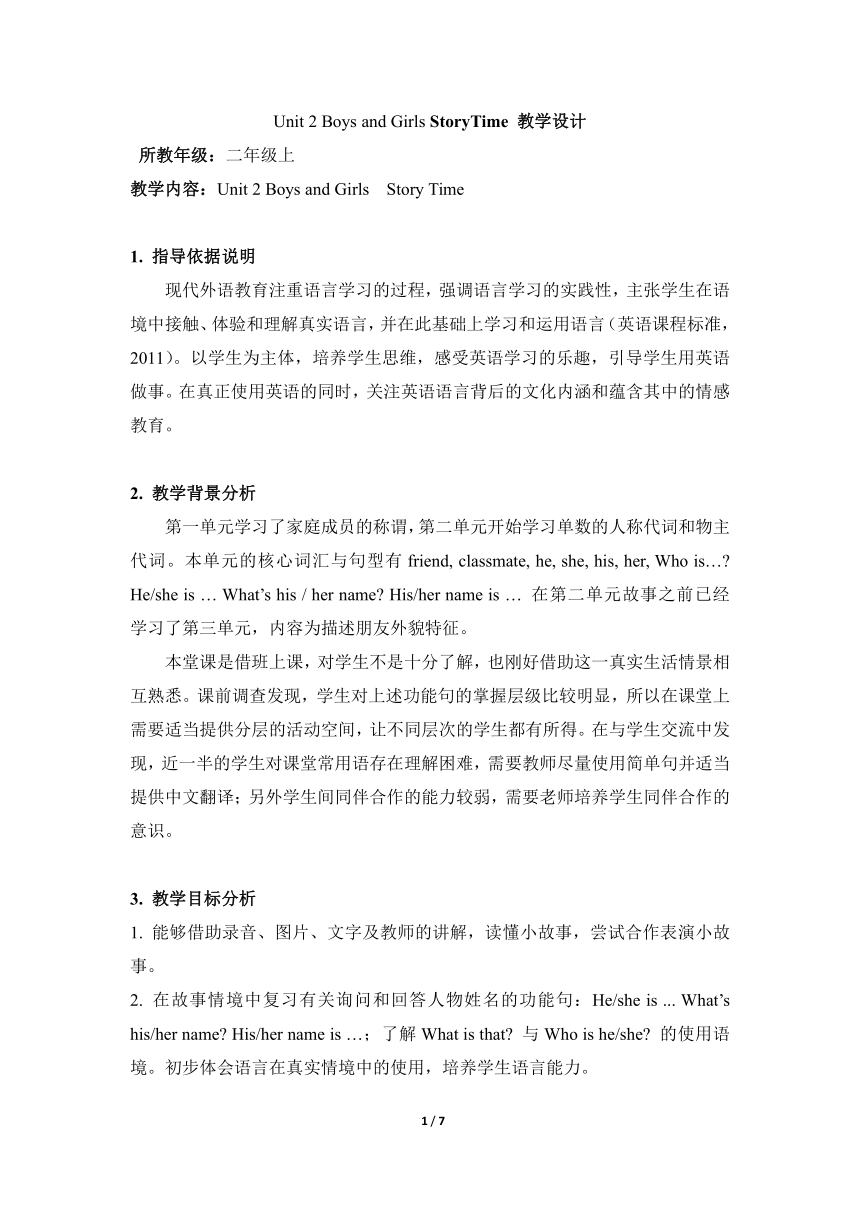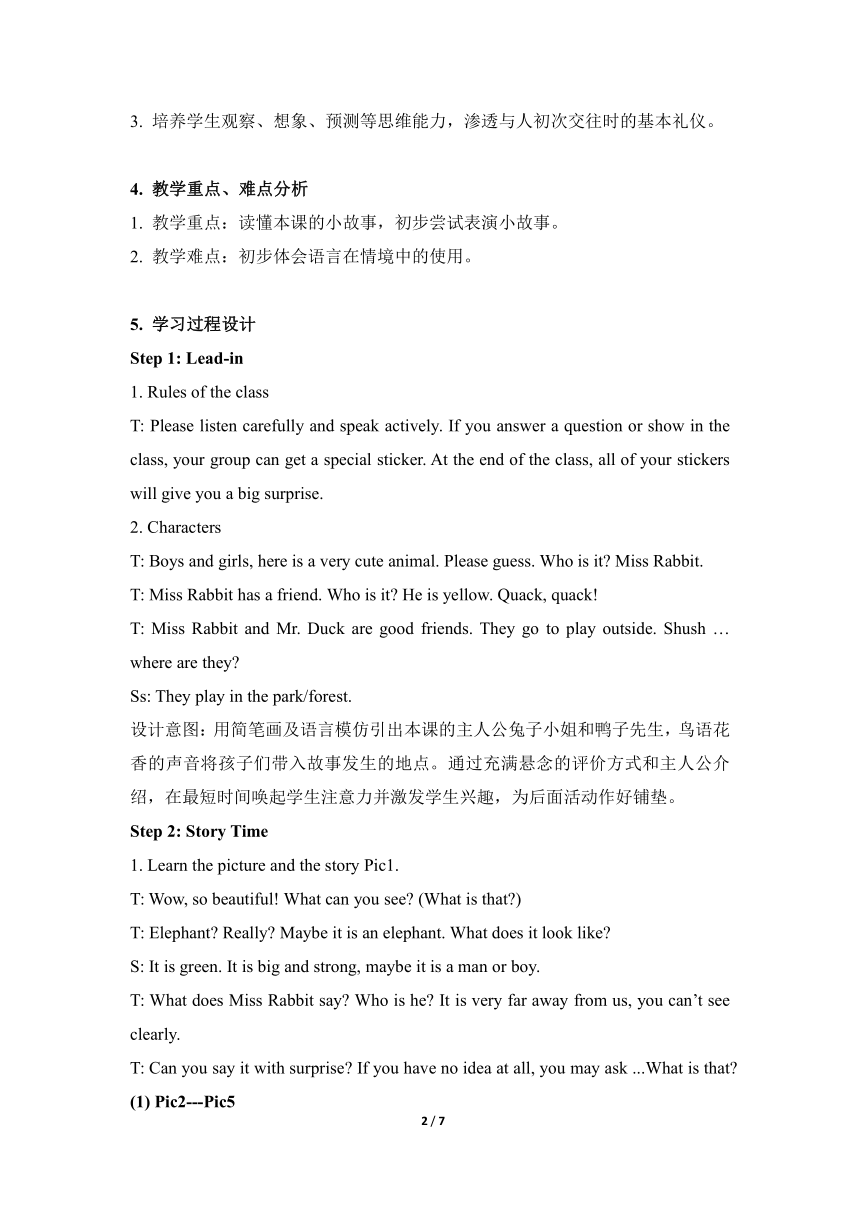Unit 2 Boys and Girls Story Time 教案(含反思)
文档属性
| 名称 | Unit 2 Boys and Girls Story Time 教案(含反思) |  | |
| 格式 | zip | ||
| 文件大小 | 123.5KB | ||
| 资源类型 | 教案 | ||
| 版本资源 | 人教(新起点) | ||
| 科目 | 英语 | ||
| 更新时间 | 2019-09-06 15:00:13 | ||
图片预览



文档简介
Unit 2 Boys and Girls StoryTime 教学设计
所教年级:二年级上
教学内容:Unit 2 Boys and Girls Story Time
1. 指导依据说明
现代外语教育注重语言学习的过程,强调语言学习的实践性,主张学生在语境中接触、体验和理解真实语言,并在此基础上学习和运用语言(英语课程标准,2011)。以学生为主体,培养学生思维,感受英语学习的乐趣,引导学生用英语做事。在真正使用英语的同时,关注英语语言背后的文化内涵和蕴含其中的情感教育。
2. 教学背景分析
第一单元学习了家庭成员的称谓,第二单元开始学习单数的人称代词和物主代词。本单元的核心词汇与句型有friend, classmate, he, she, his, her, Who is…? He/she is … What’s his / her name? His/her name is … 在第二单元故事之前已经学习了第三单元,内容为描述朋友外貌特征。
本堂课是借班上课,对学生不是十分了解,也刚好借助这一真实生活情景相互熟悉。课前调查发现,学生对上述功能句的掌握层级比较明显,所以在课堂上需要适当提供分层的活动空间,让不同层次的学生都有所得。在与学生交流中发现,近一半的学生对课堂常用语存在理解困难,需要教师尽量使用简单句并适当提供中文翻译;另外学生间同伴合作的能力较弱,需要老师培养学生同伴合作的意识。
3. 教学目标分析
1. 能够借助录音、图片、文字及教师的讲解,读懂小故事,尝试合作表演小故事。
2. 在故事情境中复习有关询问和回答人物姓名的功能句:He/she is ... What’s his/her name? His/her name is …;了解What is that? 与Who is he/she? 的使用语境。初步体会语言在真实情境中的使用,培养学生语言能力。
3. 培养学生观察、想象、预测等思维能力,渗透与人初次交往时的基本礼仪。
4. 教学重点、难点分析
1. 教学重点:读懂本课的小故事,初步尝试表演小故事。
2. 教学难点:初步体会语言在情境中的使用。
5. 学习过程设计
Step 1: Lead-in
1. Rules of the class
T: Please listen carefully and speak actively. If you answer a question or show in the class, your group can get a special sticker. At the end of the class, all of your stickers will give you a big surprise.
2. Characters
T: Boys and girls, here is a very cute animal. Please guess. Who is it? Miss Rabbit.
T: Miss Rabbit has a friend. Who is it? He is yellow. Quack, quack!
T: Miss Rabbit and Mr. Duck are good friends. They go to play outside. Shush … where are they?
Ss: They play in the park/forest.
设计意图:用简笔画及语言模仿引出本课的主人公兔子小姐和鸭子先生,鸟语花香的声音将孩子们带入故事发生的地点。通过充满悬念的评价方式和主人公介绍,在最短时间唤起学生注意力并激发学生兴趣,为后面活动作好铺垫。
Step 2: Story Time
1. Learn the picture and the story Pic1.
T: Wow, so beautiful! What can you see? (What is that?)
T: Elephant? Really? Maybe it is an elephant. What does it look like?
S: It is green. It is big and strong, maybe it is a man or boy.
T: What does Miss Rabbit say? Who is he? It is very far away from us, you can’t see clearly.
T: Can you say it with surprise? If you have no idea at all, you may ask ...What is that? (1) Pic2---Pic5
Pic2. T: Look, it is coming. It is near to Miss Rabbit and Mr. Duck. What does Miss Rabbit say? Is he a boy? How does Miss Rabbit feel? Afraid. Can you read with the emotion?
Pic3. T: It is close to us. What does Mr. Duck say? Is he a man? How does Mr. Duck feel? A little scared. How do you know that?
Pic4. T: What does Miss Rabbit say? Is he a tiger? How do they feel? Scared. If the tiger is coming, what will happen? The tiger may eat us.
T: Let’s try to Read P2—P5 quickly with emotion. (1. T: Miss Rabbit, Ss: Mr. Duck; 2. Pair work)
Pic5. No! Aagghh! Look, what happened to Mr. Duck? Fall down to the ground. How do they feel? Why? Terribly scared. Safe of dangerous? What do they want to do? (Escape, run for your life.) (If you and your friends are in danger, what should you do?) Please do it with emotion in pair.
T: The elephant shakes off the leaves and flowers. Can you shake off something like that?
(2) Pic6.
T: Actually, who is he? Oh, he’s my friend. The duck is released. How does the elephant feel? How do you know that? Where is the rabbit? (She hides behind the stone. Because the rabbit doesn’t know him, still worried.)
(3) Pic7-8.
T: She says “What’s his name?” His name is Tiny. Why is Miss Rabbit so surprised? Tiny, that means very small. It is humors.
设计意图:
1. 将部分图片整合后,学生以不同的节奏观察图片、感知语言、模仿语音,进而理解故事中人物情感,更好地培养了学生的读图能力和预测想象能力。
2. 对于较难的词汇tiny,用图片对比形式,帮助学生理解英美文化中名字特有的幽默感。
2. Read the story (1) Enjoy the cartoon (2) Listen, point and repeat. (3) Enjoy the book
T: Now it’s time for you to enjoy the book by yourself. You can read in small voice 2 minutes. Please go ahead!
3. Act the story
(1) Greeting---Pic8.
T: The Elephant meet Miss Rabbit for the first time. She is his new friend, what will the elephant say? Hello, hi, or nice to meet you! How about Miss Rabbit?
(2) Model
T: I want to be Miss Rabbit. Who want to be the elephant Tiny? Who want to be Mr. Duck? Would you all be the director?
(3) Practice and show
T: How many roles are there in the story? Miss Rabbit, Mr. Duck and the elephant Tiny, we also need a director. Four students in a group. Please role play, and you may show for the class later.
设计意图:
1. 通过预测大象接下来的语言,给学生提供思维的空间,同时渗透认识新朋友时的基本礼仪。
2. 在合作表演的故事情境中,检测并加深对故事的理解,体会如何询问或回答关于人物姓名的问题。
Step 3: Play Time(备选层级活动)
1. Let’s guess
(1) Friends in the park
T: Miss Rabbit and Mr. Duck have many friends in the park. Let’s see who they are. Ss: Who is…? What’s his/her name?
Ss: That/he/she is… His/her name is…
(2) Friends around us
T: Melody has a friend. She is a girl. She is thin. She is pretty. Who is she? Yes. She is Ms. Yin. Who are your friend?
2. Big surprise
T: As for your great performance, each group has many cards. Put the cards together in a special order, you will get a surprise—a new friend. Please named it and put your surprise on the blackboard.
E.g. Group1: He is a dog. His name is Lucky. He is big. He is very cute, I like it.
3. Know more about names
T: In different situation, people ask names in different ways. For examples: May I have your name? Your name! Excuse me, could I have your family name?
设计意图:
1. 如果学生前半部分掌握较好,可以适当提高难度,进行备选拓展活动。
2. 延伸故事情景场景,猜测公园里的更多动物朋友和人;再进一步衍生, 通过服装、通过外貌等特征猜测某位老师或同学的朋友。
3. 教师在猜测中为学生创设情境练习语言,同时进行人物描述词汇的输入和唤醒,最终引导孩子学生用小语段介绍自己的朋友。
4. 评价方式体现多样化与过程性,将小组活动的拼图与课堂内容相联系,增强趣味性与时效性。通过富有多重意义的拼图,也让学生感受到个人对小组的贡献,小组合作的力量,多个小组的力量,渗透人与动物为友,人与自然为友的乐趣。
Step 4:Homework
1. Try to know one of your parents’ friend.
2. Check for more interesting things about asking and giving names in different culture.
设计意图:
1. 为了能在恰当的情景中初步问答人物姓名,渗透了小部分问答名字的中西文化差异。
2. 开放的课后延伸为不同层级学生的学习提供了引导。
6. 板书设计:
7. 教学特色与反思:
在课本故事的童话情境中,使用了拟人的手法,小兔子和小鸭子看到由远及近走来的庞然大物,不知道是谁,但感觉是比较有力量的男性,逐渐心生怕意,猜测时这样询问: .Who is he? Is he a boy/man/tiger…?在日常生活中,不知道远处的东西是什么的情况下,猜测或询问时可以使用这样的语言:.What is that? Is that a …?如果知道是人,但不知男女的情况下(例如屋外忽然有人敲门),可以使用的语言有Who is it?或者猜测较远或近处的某人是谁时用Who is that/this?;如果确定了性别,但不知道姓名或具体是谁时,可以使用Who is he/she? Is he/she …?在本课故事教学之后,可以再次结合本故事中的语言,进行适当的情景拓展与语言扩充,增加更多真实语言情境帮助学生理解感受语言的真实使用。
本节课的主要教学特色有:
1. 基于教材,不限于教材,更贴近生活语境。在让学生理解故事语言的同时,增加了猜测动物、人物,描述同学、老师、拼图等不同的语言情境。
2. 基于语言,不限于语言,更关注语言能力。基于故事中的基本功能句,预测故事情节,并通过猜测人物和动物影像、通过人物和动物等特征的描述和猜测等激发学生思维,用语言来做事。
3. 基于评价,不限于评价,更注重核心素养。每次回答问题或者深度参与课堂,都会为小组赢得一片拼图,每组获得的拼图集合成一个神秘的人物或者动物或者花草气球等装饰物。学生可以尝试用本课的语言去描述他们的拼图成果。最终7个组的拼图呈现在黑板上,形成了故事人物、身边同学、动画人物、大自然的大家庭。所有的Boys和Girls 共同享受快乐的时光。将过程性的评价与个人参与、小组合作、班级合作、语言练习与创作、思维品质、学习能力和文化意识等相结合。
7 / 7
所教年级:二年级上
教学内容:Unit 2 Boys and Girls Story Time
1. 指导依据说明
现代外语教育注重语言学习的过程,强调语言学习的实践性,主张学生在语境中接触、体验和理解真实语言,并在此基础上学习和运用语言(英语课程标准,2011)。以学生为主体,培养学生思维,感受英语学习的乐趣,引导学生用英语做事。在真正使用英语的同时,关注英语语言背后的文化内涵和蕴含其中的情感教育。
2. 教学背景分析
第一单元学习了家庭成员的称谓,第二单元开始学习单数的人称代词和物主代词。本单元的核心词汇与句型有friend, classmate, he, she, his, her, Who is…? He/she is … What’s his / her name? His/her name is … 在第二单元故事之前已经学习了第三单元,内容为描述朋友外貌特征。
本堂课是借班上课,对学生不是十分了解,也刚好借助这一真实生活情景相互熟悉。课前调查发现,学生对上述功能句的掌握层级比较明显,所以在课堂上需要适当提供分层的活动空间,让不同层次的学生都有所得。在与学生交流中发现,近一半的学生对课堂常用语存在理解困难,需要教师尽量使用简单句并适当提供中文翻译;另外学生间同伴合作的能力较弱,需要老师培养学生同伴合作的意识。
3. 教学目标分析
1. 能够借助录音、图片、文字及教师的讲解,读懂小故事,尝试合作表演小故事。
2. 在故事情境中复习有关询问和回答人物姓名的功能句:He/she is ... What’s his/her name? His/her name is …;了解What is that? 与Who is he/she? 的使用语境。初步体会语言在真实情境中的使用,培养学生语言能力。
3. 培养学生观察、想象、预测等思维能力,渗透与人初次交往时的基本礼仪。
4. 教学重点、难点分析
1. 教学重点:读懂本课的小故事,初步尝试表演小故事。
2. 教学难点:初步体会语言在情境中的使用。
5. 学习过程设计
Step 1: Lead-in
1. Rules of the class
T: Please listen carefully and speak actively. If you answer a question or show in the class, your group can get a special sticker. At the end of the class, all of your stickers will give you a big surprise.
2. Characters
T: Boys and girls, here is a very cute animal. Please guess. Who is it? Miss Rabbit.
T: Miss Rabbit has a friend. Who is it? He is yellow. Quack, quack!
T: Miss Rabbit and Mr. Duck are good friends. They go to play outside. Shush … where are they?
Ss: They play in the park/forest.
设计意图:用简笔画及语言模仿引出本课的主人公兔子小姐和鸭子先生,鸟语花香的声音将孩子们带入故事发生的地点。通过充满悬念的评价方式和主人公介绍,在最短时间唤起学生注意力并激发学生兴趣,为后面活动作好铺垫。
Step 2: Story Time
1. Learn the picture and the story Pic1.
T: Wow, so beautiful! What can you see? (What is that?)
T: Elephant? Really? Maybe it is an elephant. What does it look like?
S: It is green. It is big and strong, maybe it is a man or boy.
T: What does Miss Rabbit say? Who is he? It is very far away from us, you can’t see clearly.
T: Can you say it with surprise? If you have no idea at all, you may ask ...What is that? (1) Pic2---Pic5
Pic2. T: Look, it is coming. It is near to Miss Rabbit and Mr. Duck. What does Miss Rabbit say? Is he a boy? How does Miss Rabbit feel? Afraid. Can you read with the emotion?
Pic3. T: It is close to us. What does Mr. Duck say? Is he a man? How does Mr. Duck feel? A little scared. How do you know that?
Pic4. T: What does Miss Rabbit say? Is he a tiger? How do they feel? Scared. If the tiger is coming, what will happen? The tiger may eat us.
T: Let’s try to Read P2—P5 quickly with emotion. (1. T: Miss Rabbit, Ss: Mr. Duck; 2. Pair work)
Pic5. No! Aagghh! Look, what happened to Mr. Duck? Fall down to the ground. How do they feel? Why? Terribly scared. Safe of dangerous? What do they want to do? (Escape, run for your life.) (If you and your friends are in danger, what should you do?) Please do it with emotion in pair.
T: The elephant shakes off the leaves and flowers. Can you shake off something like that?
(2) Pic6.
T: Actually, who is he? Oh, he’s my friend. The duck is released. How does the elephant feel? How do you know that? Where is the rabbit? (She hides behind the stone. Because the rabbit doesn’t know him, still worried.)
(3) Pic7-8.
T: She says “What’s his name?” His name is Tiny. Why is Miss Rabbit so surprised? Tiny, that means very small. It is humors.
设计意图:
1. 将部分图片整合后,学生以不同的节奏观察图片、感知语言、模仿语音,进而理解故事中人物情感,更好地培养了学生的读图能力和预测想象能力。
2. 对于较难的词汇tiny,用图片对比形式,帮助学生理解英美文化中名字特有的幽默感。
2. Read the story (1) Enjoy the cartoon (2) Listen, point and repeat. (3) Enjoy the book
T: Now it’s time for you to enjoy the book by yourself. You can read in small voice 2 minutes. Please go ahead!
3. Act the story
(1) Greeting---Pic8.
T: The Elephant meet Miss Rabbit for the first time. She is his new friend, what will the elephant say? Hello, hi, or nice to meet you! How about Miss Rabbit?
(2) Model
T: I want to be Miss Rabbit. Who want to be the elephant Tiny? Who want to be Mr. Duck? Would you all be the director?
(3) Practice and show
T: How many roles are there in the story? Miss Rabbit, Mr. Duck and the elephant Tiny, we also need a director. Four students in a group. Please role play, and you may show for the class later.
设计意图:
1. 通过预测大象接下来的语言,给学生提供思维的空间,同时渗透认识新朋友时的基本礼仪。
2. 在合作表演的故事情境中,检测并加深对故事的理解,体会如何询问或回答关于人物姓名的问题。
Step 3: Play Time(备选层级活动)
1. Let’s guess
(1) Friends in the park
T: Miss Rabbit and Mr. Duck have many friends in the park. Let’s see who they are. Ss: Who is…? What’s his/her name?
Ss: That/he/she is… His/her name is…
(2) Friends around us
T: Melody has a friend. She is a girl. She is thin. She is pretty. Who is she? Yes. She is Ms. Yin. Who are your friend?
2. Big surprise
T: As for your great performance, each group has many cards. Put the cards together in a special order, you will get a surprise—a new friend. Please named it and put your surprise on the blackboard.
E.g. Group1: He is a dog. His name is Lucky. He is big. He is very cute, I like it.
3. Know more about names
T: In different situation, people ask names in different ways. For examples: May I have your name? Your name! Excuse me, could I have your family name?
设计意图:
1. 如果学生前半部分掌握较好,可以适当提高难度,进行备选拓展活动。
2. 延伸故事情景场景,猜测公园里的更多动物朋友和人;再进一步衍生, 通过服装、通过外貌等特征猜测某位老师或同学的朋友。
3. 教师在猜测中为学生创设情境练习语言,同时进行人物描述词汇的输入和唤醒,最终引导孩子学生用小语段介绍自己的朋友。
4. 评价方式体现多样化与过程性,将小组活动的拼图与课堂内容相联系,增强趣味性与时效性。通过富有多重意义的拼图,也让学生感受到个人对小组的贡献,小组合作的力量,多个小组的力量,渗透人与动物为友,人与自然为友的乐趣。
Step 4:Homework
1. Try to know one of your parents’ friend.
2. Check for more interesting things about asking and giving names in different culture.
设计意图:
1. 为了能在恰当的情景中初步问答人物姓名,渗透了小部分问答名字的中西文化差异。
2. 开放的课后延伸为不同层级学生的学习提供了引导。
6. 板书设计:
7. 教学特色与反思:
在课本故事的童话情境中,使用了拟人的手法,小兔子和小鸭子看到由远及近走来的庞然大物,不知道是谁,但感觉是比较有力量的男性,逐渐心生怕意,猜测时这样询问: .Who is he? Is he a boy/man/tiger…?在日常生活中,不知道远处的东西是什么的情况下,猜测或询问时可以使用这样的语言:.What is that? Is that a …?如果知道是人,但不知男女的情况下(例如屋外忽然有人敲门),可以使用的语言有Who is it?或者猜测较远或近处的某人是谁时用Who is that/this?;如果确定了性别,但不知道姓名或具体是谁时,可以使用Who is he/she? Is he/she …?在本课故事教学之后,可以再次结合本故事中的语言,进行适当的情景拓展与语言扩充,增加更多真实语言情境帮助学生理解感受语言的真实使用。
本节课的主要教学特色有:
1. 基于教材,不限于教材,更贴近生活语境。在让学生理解故事语言的同时,增加了猜测动物、人物,描述同学、老师、拼图等不同的语言情境。
2. 基于语言,不限于语言,更关注语言能力。基于故事中的基本功能句,预测故事情节,并通过猜测人物和动物影像、通过人物和动物等特征的描述和猜测等激发学生思维,用语言来做事。
3. 基于评价,不限于评价,更注重核心素养。每次回答问题或者深度参与课堂,都会为小组赢得一片拼图,每组获得的拼图集合成一个神秘的人物或者动物或者花草气球等装饰物。学生可以尝试用本课的语言去描述他们的拼图成果。最终7个组的拼图呈现在黑板上,形成了故事人物、身边同学、动画人物、大自然的大家庭。所有的Boys和Girls 共同享受快乐的时光。将过程性的评价与个人参与、小组合作、班级合作、语言练习与创作、思维品质、学习能力和文化意识等相结合。
7 / 7
同课章节目录
- Unit 1 My Family
- Lesson 1
- Lesson 2
- Lesson 3
- Unit 2 Boys and Girls
- Lesson 1
- Lesson 2
- Lesson 3
- Unit 3 My Friends
- Lesson 1
- Lesson 2
- Lesson 3
- Revision 1
- Unit 4 In the Community
- Lesson 1
- Lesson 2
- Lesson 3
- Unit 5 In the Park
- Lesson 1
- Lesson 2
- Lesson 3
- Unit 6 Happy Holidays
- Lesson 1
- Lesson 2
- Lesson 3
- Revision 2
